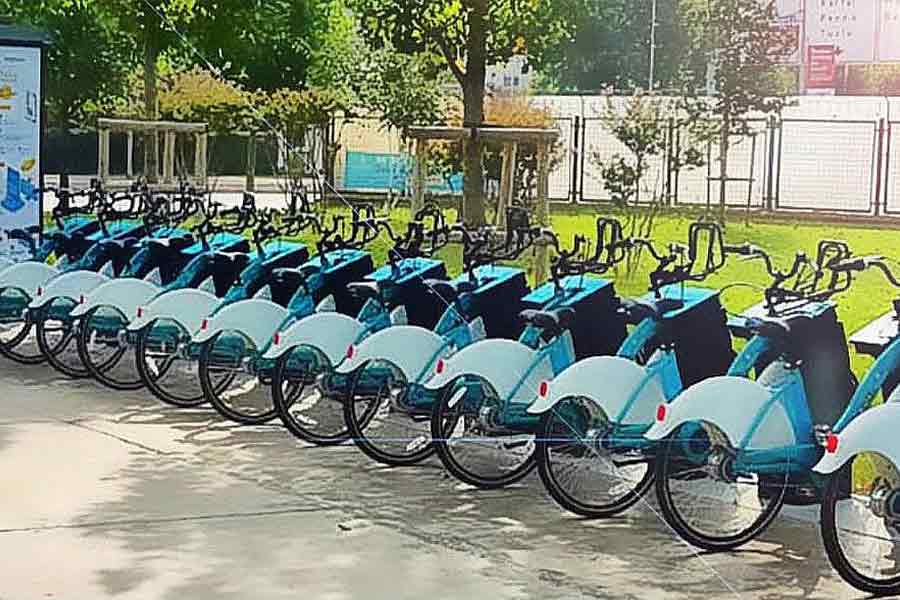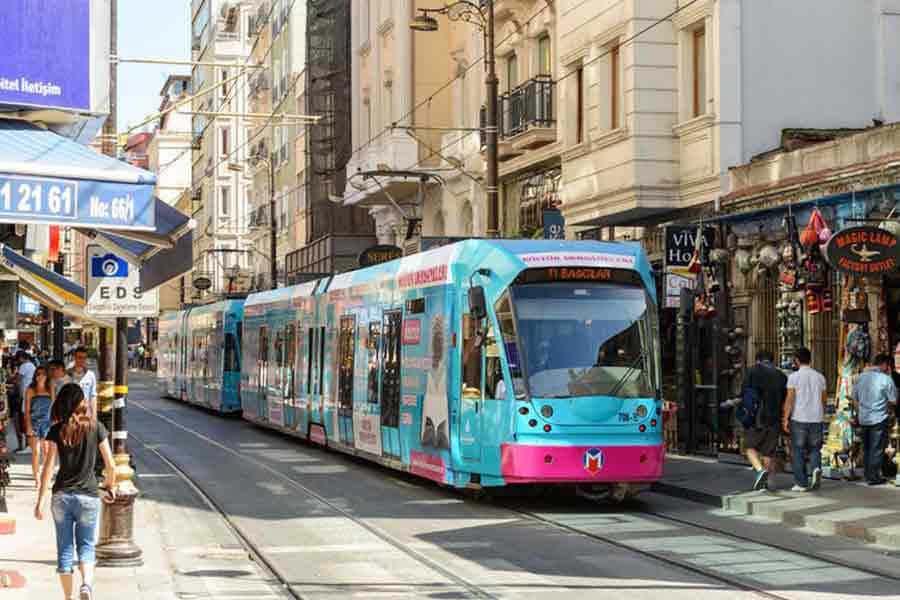The best ways to get around Istanbul are the buses and trams, which conveniently cover the tourist areas. But remember, buses don't have maps inside and drivers do not announce stops, so you'll need to remain vigilant and watch where you are going. The metro is also a reliable and cheap means of getting around; however, stops are farther apart and not as well-positioned for seeing the sights. The city's metro and bus networks can also be used to get to downtown from Istanbul Atatürk Airport (IST). When visiting Sultanahmet and Eminönü, walking between the area's attractions is doable, but you'll need to rely on another mode of transportation to reach other neighborhoods. Driving is strongly discouraged since road signs are in Turkish and accidents are fairly common. Ferries are also available to get to the Princes' Islands and between the European and Asian sides.
 First Things First – The Istanbul Card
First Things First – The Istanbul Card
The Istanbul Card, or IstanbulKart as you’ll see it named, is how you pay for public transport in the city.
It’s worth buying this at the airport if you can as you’ll need it to get to where you’re staying. You can buy a new card at any of the yellow or blue machines in the airport, and you can also purchase them from kiosks in the city where you see the IstanbulKart sign.
You will pay just 13 Lira for a card, and it will come with no credit loaded onto it.
Istanbul Public Transport
There are several different types of public transport you can use to get around Istanbul. While you can walk between certain places, remember that distances are pretty large. You might think somewhere looks walkable, but once you set off, you’ll think otherwise!
It’s also not the best idea to hire a car and try and drive in Istanbul. The traffic, the roads, the beeping, oh, it’s enough to drive you crazy! Seriously, save yourself the stress and use public transport instead.
You’ll find hand sanitizer stations around, but it’s best to carry a small bottle in your bag or pocket and spray your hands once you get off the bus/Metro. Also, obviously remember not to touch your face while on public transport. Of course, with COVID-19 restrictions, that means wearing a mask on all public transport and in stations – masks are currently mandatory in Turkey anyway, so this shouldn’t come as a surprise.
1. Ferry
 The vapur (ferry) is the best way to get from the European to the Asian side (or vice versa) when the bridge is absolutely full of cars. Rush hour starts at around 8AM and ends 6PM on weekdays, so lots of people commuting to and from work prefer to glide over the Bosphorus instead. There are three main ferry stations on the European side: Beşiktaş, Kabataş (currently under construction) and Karaköy. There is also Eminönü, from where ferries go directly to the Kadıköy Ferry Station on the Asian side. You can check out the timetables for all Istanbul ferries (including Bosphorus tours) via the Şehir Hatları website. As an alternative, the Ido and Dentur Avrasya deniz otobüsleri (sea buses) also take off from Beşiktaş and Kabataş and go to different areas of the Asian side, as well as the islands.
The vapur (ferry) is the best way to get from the European to the Asian side (or vice versa) when the bridge is absolutely full of cars. Rush hour starts at around 8AM and ends 6PM on weekdays, so lots of people commuting to and from work prefer to glide over the Bosphorus instead. There are three main ferry stations on the European side: Beşiktaş, Kabataş (currently under construction) and Karaköy. There is also Eminönü, from where ferries go directly to the Kadıköy Ferry Station on the Asian side. You can check out the timetables for all Istanbul ferries (including Bosphorus tours) via the Şehir Hatları website. As an alternative, the Ido and Dentur Avrasya deniz otobüsleri (sea buses) also take off from Beşiktaş and Kabataş and go to different areas of the Asian side, as well as the islands.
2. Metro and Marmaray
Istanbul’s ever-expanding metro lines extend for more than 80 miles, connecting up new parts of the city as it grows. Most visitors probably won’t need to use any lines other than the M2 between Hacıosman and Yenikapı, which passes through the business and shopping districts around Levent, Taksim Square and Şişhane in Beyoğlu, and across the Golden Horn. A separate underground rail system, the Marmaray, connects with the metro at Yenikapı and goes under the Bosphorus in a tunnel to the Asian side.
3. Taxis
The taxis in Istanbul are yellow and have taxi signs on the roof. It’s easy to find a yellow taxi almost anywhere in the streets. Taxis are cheap compared to European levels. There is no day and night difference. You can calculate the approximate taxi fare for your journey with this formula.
4. Metrobus
The metrobus definitely has its pros and cons when it comes to its reputation. At first glance it’s a great alternative, because the metrobuses have their own lanes, allowing them to drive right through the traffic, taking passengers all the way from one end of the city to the other (see map). However, because the metrobus makes frequent stops, it’s also infamous for its packed-to-the-limit rides, so expect to get uncomfortably close to other passengers and prepare for potentially low personal hygiene standards.
5. Bicycle and scooter
Bicycles are little-used as daily transportation in Istanbul, and given the lack of bike lanes and driver awareness of cyclists, it’s not recommended as a way of getting around. There are, however, pleasant places for a recreational ride, particularly alongside the Bosphorus and on the Marmara shoreline on both the European and Asian sides of the city. The app-based municipal bike rental system İSBİKE has stations along all those coasts. The Princes’ Islands are a popular spot to ride bikes too. Marti brand electric scooters are increasingly ubiquitous as well.
6. On Foot
You'll find walking is easy and enjoyable in neighborhoods like Sultanahmet and Eminönü, but other areas are less dense. Definitely explore the alleys and bazaars on foot, but hop on a bus or tram if you are going greater distances. Also, be sure to carry a reliable map.
7. Tram, funicular and cable car
Of Istanbul’s four modern tram lines, the one likely of most use to visitors is the T1, which starts near the Kabataş ferry terminal and runs across the Galata Bridge and past the sights of Sultanahmet. There’s also a tram (T5) alongside the Golden Horn that stops in the colorful neighborhoods of Fener, Balat and Eyüp, and a tram (T3) that winds through the Kadıköy district on Istanbul’s Asian side. Two funicular lines, one between Karaköy and Tünel Square and the other between Kabataş and Taksim Square, connect the T1 tram with the pedestrianized shopping and entertainment area around İstiklal Caddesi, saving a steep uphill hike. From the Eyüp stop of the T1, a cable car goes up to the popular Pierre Loti café and viewing area.






